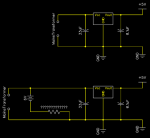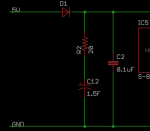I want to build a special LED clock as a gift, powered by mains through a 6V transformer and a 5V power regulator. I have over the past year worked on some prototypes and am confident that I can make the doing-part work just fine. Im running on about 4.9V all said and done in the prototypes.
However, the location where this clock will end up as home is on an old country circuit that frequently gets brownouts and transient blackouts long enough to clear the time settings, and require them to reset the clock each time.
I would like to consider grabbing some rechargable cells from my local electronic shops, in whatever form may be best - rechargable phone packs, individual cells ... 1.2V x 4 NiMH or NiCad... and integrating them into the circuit so that they act as a battery backup for a few minutes (usually will only need to buffer a few seconds to 30 seconds).
If it was just brownouts, i'd figure a few big capacitors would do the trick, but dont know exactly how big/many for ie 20 seconds of runtime, but i do want it to ride out most of the outages that will be on the scale of a minute.
How do I add rechargable batteries into the circuit such that they recharge safely, but when the mains power is lost, the battery power then feeds the circuit. V1in is my 6V wall transformer, V1out is my ~5V regulator output, used to then power the main circuit. I know that they need some sort of charging circuit to control them and read in some places its a microprocessor controlled charging circuit, but not sure how, and how to integrate their power as a source when V1in drops to 0V
I have choices of 1A and 0.5A regulators, my circuit doesn't draw that much. I have wall transformers at 6V that deliver 0.6A and 1.0A that i can use (and i can find others if needed) in case big amps are needed for charging circuits..
V1in (6V) ===== [REGULATOR] ===== V1out (5V)
GND ============*============GND
I have a library of picaxe chips, lots of 08, 08M, 18X, 20X, 28X and 28X2s and a few others to call on. If i need to make a separate charging circuit with microcontroller feedback, i'd prefer it that way rather than tying it into the main circuit chip, because if I get a good solution, i'll likely include a rechargable battery backup module in several projects, and can just build that as a separate black box.
Some pointing into the right direction to make sense of what is needed, an implimentable solution is very much appreciated.
However, the location where this clock will end up as home is on an old country circuit that frequently gets brownouts and transient blackouts long enough to clear the time settings, and require them to reset the clock each time.
I would like to consider grabbing some rechargable cells from my local electronic shops, in whatever form may be best - rechargable phone packs, individual cells ... 1.2V x 4 NiMH or NiCad... and integrating them into the circuit so that they act as a battery backup for a few minutes (usually will only need to buffer a few seconds to 30 seconds).
If it was just brownouts, i'd figure a few big capacitors would do the trick, but dont know exactly how big/many for ie 20 seconds of runtime, but i do want it to ride out most of the outages that will be on the scale of a minute.
How do I add rechargable batteries into the circuit such that they recharge safely, but when the mains power is lost, the battery power then feeds the circuit. V1in is my 6V wall transformer, V1out is my ~5V regulator output, used to then power the main circuit. I know that they need some sort of charging circuit to control them and read in some places its a microprocessor controlled charging circuit, but not sure how, and how to integrate their power as a source when V1in drops to 0V
I have choices of 1A and 0.5A regulators, my circuit doesn't draw that much. I have wall transformers at 6V that deliver 0.6A and 1.0A that i can use (and i can find others if needed) in case big amps are needed for charging circuits..
V1in (6V) ===== [REGULATOR] ===== V1out (5V)
GND ============*============GND
I have a library of picaxe chips, lots of 08, 08M, 18X, 20X, 28X and 28X2s and a few others to call on. If i need to make a separate charging circuit with microcontroller feedback, i'd prefer it that way rather than tying it into the main circuit chip, because if I get a good solution, i'll likely include a rechargable battery backup module in several projects, and can just build that as a separate black box.
Some pointing into the right direction to make sense of what is needed, an implimentable solution is very much appreciated.



